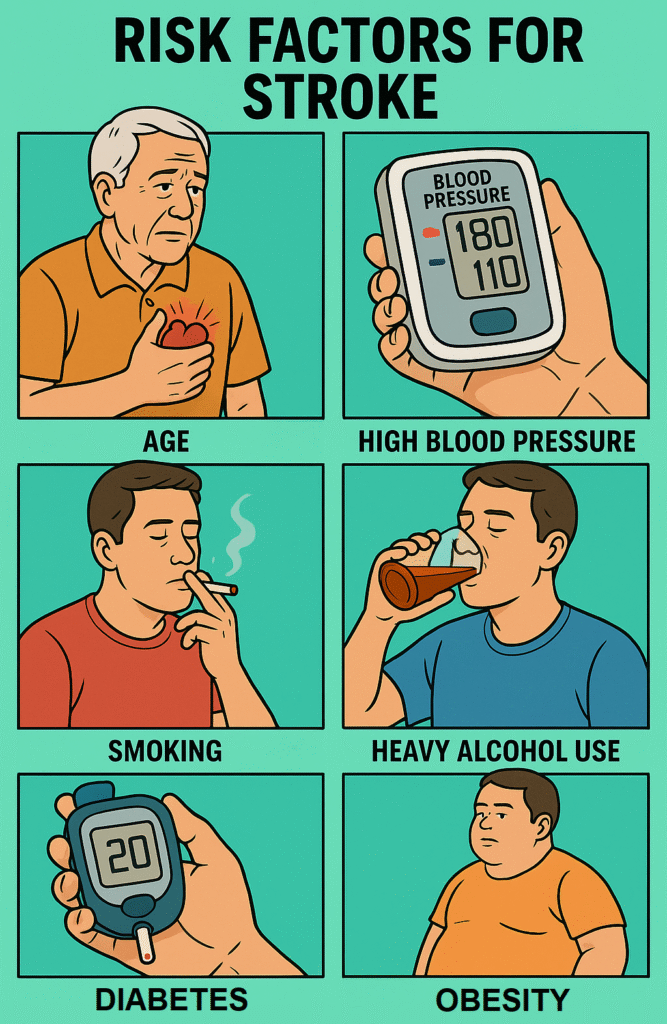What is Stroke?
Have you ever heard someone say, “My uncle had a stroke and can’t move one side of his body now”? That’s not just a random health scare—it’s a medical emergency called a stroke.
A stroke happens when the blood flow to a part of the brain is suddenly cut off or severely reduced. Just like your phone shuts down without charging, your brain cells begin to die within minutes if they don’t get oxygen from the blood. And once brain cells are gone, they’re gone for good.
Globally, stroke is the second leading cause of death and a major cause of long-term disability. According to the World Health Organization, over 12 million people experience strokes every year, and around 6.5 million die from it
How Does a Stroke Occur?
Let’s imagine your brain is like a bustling city. Blood vessels are the roads, and blood is the delivery truck bringing oxygen and nutrients. If a road is blocked (ischaemic stroke) or bursts (haemorrhagic stroke), the city can’t function.
There are two main types:
- Ischemic stroke (about 85%) – happens when a blood clot or fatty deposit blocks a vessel.
- Hemorrhagic stroke (about 15%) – occurs when a blood vessel bursts, leading to bleeding in or around the brain.
A third, warning type is called a Transient Ischemic Attack (TIA), or “mini-stroke,” where symptoms last briefly but signal bigger trouble ahead.
What Causes a Stroke?
Several things can trigger a stroke, and many are avoidable. Here are some of the leading causes:
- High blood pressure (hypertension): Seen in about 77% of first-time stroke cases.
- Atherosclerosis: Hardening or narrowing of the arteries due to plaque build-up.
- Heart disease: Especially atrial fibrillation, which increases the risk fivefold.
- Diabetes: It doubles your stroke risk by damaging blood vessels over time.
- Smoking and alcohol: These significantly raise stroke risks.
- Obesity and sedentary lifestyle: Increase the chance of developing other stroke-related conditions.
Who Is Most at Risk? (Risk Factors)
It’s easy to assume strokes only happen to older people, but that’s not entirely true. While age is a strong risk factor, strokes can strike anyone.
Here are key risk factors:
- Age over 55: Risk doubles each decade after 55.
- Family history: Genetics do play a role.
- High blood pressure and cholesterol
- Smoking and heavy alcohol use
- Diabetes
- Lack of exercise
- Obesity
- Previous stroke or TIA
- Stress and depression
Among these, high blood pressure is the most dangerous and preventable cause.

What Are the Symptoms of Stroke?
Think fast—because speed saves lives. The symptoms usually appear suddenly:
- Face drooping: One side of the face may look uneven.
- Arm weakness: One arm might drift downward or feel numb.
- Speech difficulty: Slurred or strange speech.
- Time to call emergency services: If any of the above happens—act FAST.
Why do these symptoms occur? It’s because the brain controls everything, from how we move to how we speak. When blood stops flowing, the brain can’t send proper signals.
What Can Be Mistaken for a Stroke? (Differential Diagnosis)
Many conditions can mimic a stroke, making accurate diagnosis essential. These include:
- Migraine aura – temporary visual or sensory changes
- Seizures – can cause confusion or muscle jerking
- Low blood sugar (hypoglycemia) – can mimic confusion or weakness
- Bell’s palsy – facial weakness without limb involvement
- Brain tumour – slow-growing and subtle but can mimic stroke effects
Doctors must differentiate carefully, often within minutes.
How Is Stroke Diagnosed?
Speed is everything here. The gold standard to diagnose stroke is brain imaging—particularly CT (Computed Tomography) scan and MRI (Magnetic Resonance Imaging).
- CT scan: Quickly detects bleeding in the brain. Often done first.
- MRI scan: Better for early detection of ischemic strokes.
Other tests may include:
- Blood tests – to check sugar, clotting time, cholesterol
- ECG and echocardiogram – to detect heart problems
- Carotid ultrasound – to check for blockages in neck arteries
How Is Stroke Treated?
Stroke treatment depends on the type:
Ischemic Stroke (Blockage):
- tPA (Tissue Plasminogen Activator): This is a clot-busting drug. It’s the gold standard but must be given within 4.5 hours of symptom onset.
- Mechanical thrombectomy: A catheter is used to physically remove the clot—effective up to 24 hours in selected cases.
Hemorrhagic Stroke (Bleeding):
- Blood pressure control
- Surgery: To stop bleeding or relieve pressure
- Clipping or coiling for aneurysms
Other Treatments:
- Antiplatelet drugs: Like aspirin to prevent future clots.
- Blood thinners: For those with atrial fibrillation (e.g., warfarin, apixaban).
- Rehabilitation: Includes physiotherapy, occupational therapy, and speech therapy.
Can Stroke Be Prevented?
Yes, and that’s the most hopeful part. Most strokes are preventable with lifestyle changes:
- Control blood pressure
- Quit smoking
- Exercise regularly
- Eat a healthy diet
- Manage diabetes and cholesterol
- Limit alcohol
- Regular health check-ups
It’s like doing maintenance on your car. A little effort now can prevent a breakdown later.
References
- World Health Organization. (2023). The Top 10 Causes of Death. https://www.who.int/news-room/fact-sheets/detail/the-top-10-causes-of-death
- Centers for Disease Control and Prevention (CDC). Stroke Facts. https://www.cdc.gov/stroke/facts.htm
- American Stroke Association. Stroke Treatment Guidelines. https://www.stroke.org/en/about-stroke/treatment
- Mayo Clinic. Stroke – Symptoms and Causes. https://www.mayoclinic.org/diseases-conditions/stroke/symptoms-causes/syc-20350113
- National Institute of Neurological Disorders and Stroke (NINDS). Stroke Information Page. https://www.ninds.nih.gov/health-information/disorders/stroke
